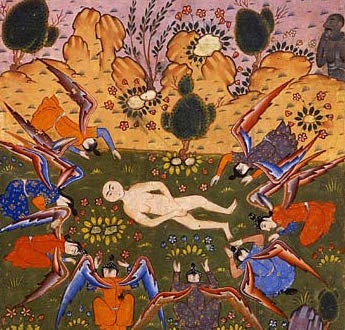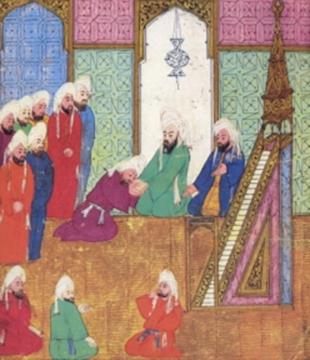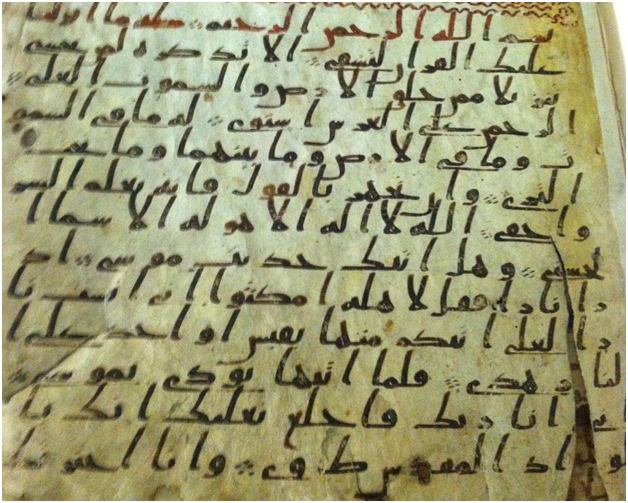Sunni Tafsīr Commentaries on the Qurʾanic Term Khalīfah
by Han Hsien LIEW*
The Arabic term khalīfah, a noun in the singular, appears twice in the Qur’an, once in reference to the original man Adam:
And when your Lord said to the angels, ‘Verily I am making on earth a khalīfah’ …
(Q 2:30)

Medieval Persian miniature depicting angels prostrating before Adam. (Image from Wikimedia Commons, cropped to illustration only.)
and once in reference to the prophet-king David:
O David, we have made you a khalīfah on earth…
(Q 38:26)
Due to the richness of the root kh-l-f with its manifold meanings, the interpretation of khalīfah in the Qur’an has often eluded pre-modern and modern interpreters alike. To complicate things further, khalīfah also came to be used as a political title, “caliph,” for the ruler of the Muslim community following the death of the Prophet Muhammad. Hence the question, how much of a connection did Qurʾānic exegetes make between the Qur’anic khalīfah and the ruling caliph?
In answering this question for the Umayyad period, Wadād al-Qāḍī argues that early exegetes such as Mujāhid b. Jabr (d. 103/721), Muqātil b. Sulaymān (d. 150/767), and Sufyān al-Thawrī (d. 161/777) generally did not go to great lengths to legitimate Umayyad rule by associating the Qur’anic khalīfah with the reigning caliph, but rather identified the Qur’anic term with Adam and humankind in general, who are said to have succeeded or replaced the jinn or angels on earth.
However, the boundaries between scriptural hermeneutics and political discourse became increasingly blurred as later exegetes, beginning with al-Ṭabarī (d. 310/923), introduced new clusters of terminology associated with the historical Caliphate into their interpretations of the term khalīfah in the Qur’an. In defining khalīfah in his tafsīr, al-Ṭabarī claims that “the supreme ruler (al-sulṭān al-aʿẓam) is called khalīfah, because he replaces the one who was before him, and takes his place in the affair, and is his successor (khalaf).” Most commentators after al-Ṭabarī, such as al-Thaʿlabī (d. 427/1035), al-Māwardī (d. 450/1058), and al-Wāḥidī (d. 468/1076), built on and reworked his interpretation of the term. Alongside this development, exegetes from the sixth/twelfth century onwards, such as al-Baghawī (d. 516/1122), Ibn al-Jawzī (d. 597/1200), al-Rāzī (d. 606/1209), and al-Qurṭubī (d. 671/1272), emphasized Adam’s role as khalīfat Allāh (itself a caliphal title meaning “deputy of God,” which was hitherto not used as part of the exegetes’ terminological cluster for their interpretations of Q 2:30) in implementing God’s rulings (aḥkām), commands (awāmir), and punishments (ḥudūd). These duties are largely similar to the ones used to define an imam-caliph at the beginning of every chapter on the Caliphate/Imamate found in kalām writings and certain works of fiqh, most notably in al-Māwardī’s al-Aḥkām al-sulṭānīyah and al-Ghazālī’s (d. 505/1111) al-Iqtiṣād fī’l-iʿtiqād. However, the reading of khalīfat Allāh into the Qur’an did not go entirely unopposed by all exegetes, with the most explicit objection coming from the Andalusian exegete Ibn ʿAṭīyah (d. 541/1147).
Post-Ṭabarī exegetes also allude to the first four caliphs/imams (Abu Bakr, ʿUmar, ʿUthman, and ʿAli) in their commentaries on Q 24:55:
God has promised those among you who have believed and done righteous deeds that He will surely yastakhlifannahum on earth just as He istakhlafa those who were before them …

Medieval Persian miniature depicting the accession of the Caliph Abu Bakr. (Image from Wikimedia Commons.)
Al-Thaʿlabī states that “in [Q 24:55] is a clear indication of the righteousness of the caliphate of Abu Bakr and the imamate of the rāshidūn caliphs.” Over time, the verse became a polemical platform for later Sunni exegetes such as al-Rāzī and al-Qurṭubī to establish the legitimacy of the four rāshidūn caliphs against Shiʿi claims that the Prophet Muhammad had designated ʿAli as his successor.
After the sack of Baghdad and the fall of the ʿAbbasid caliphate in 656/1258, most exegeses of the term khalīfah relied on those of previous generations. But with al-Qurṭubī’s commentary on Q 2:30, we come across the most explicit connection made between the qur’anic khalīfah and the Caliphate in reality: “This verse is the basis for the appointment of an imam and a caliph who shall be heard and obeyed, so that opinions will be united through him and [his] rulings will be implemented.” At this point he incorporates a full juristic discourse on the Caliphate reminiscent of al-Māwardī and al-Ghazālī. The Sunni discourse on the Caliphate—detailing arguments for the necessity of the Caliphate, the duties and requirements for the caliphal candidate, arguments against the Shiʿi conception of the Imamate, and other juridical issues surrounding the Caliphate—is thereby used as a hermeneutical device to explain Q 2:30. Writing about a century later, Ibn Kathīr (d. 774/1373) quotes al-Qurṭubī’s juristic discourse on the Caliphate (in an abridged form) despite inclining more towards the view that the qurʾanic term khalīfah refers to humankind in general.
In sum, to fully understand how exegetes understood the qurʾanic term khalīfah over time, one has to take into account the shared language between tafsīr and political discourse during the medieval Islamic period. The title khalīfat Allāh used in caliphal rhetoric, Sunni historical narratives of the four rāshidūn caliphs, and juristic discourses on the Caliphate left an imprint on the many interpretations of qurʾanic verses containing the Arabic root kh-l-f. This does not imply that exegetes were using such verses to legitimate the Caliphate, the consequences of which would be unthinkable for an exegete’s scholarly reputation. Rather, the exegetical commentaries on the qurʾānic khalīfah speak to the porous boundaries of tafsīr and the need to be sensitive towards not only the socio-political but also the intellectual and discursive contexts in which exegetes operate.
* Han Hsien Liew is a Ph.D. candidate in history and Middle Eastern studies at Harvard University, currently writing a dissertation on Sunni discourses on the Caliphate/Imamate between the 5th/11th and 7th/13th centuries. This blog post is based on his article newly published in Arabica 63, no. 1 (2016): 1-29.

